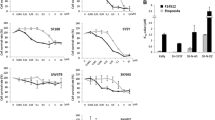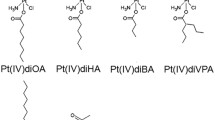Abstract
We have previously descibed the synthesis of a cytotoxic polymeric conjugate of spermine (Poly-SPM) which is able to inhibit the transport of polyamines (spermine, spermidine, and putrescine) into normal and malignant cells. Recent studies examining the toxicity of Poly-SPM in parental and multidrug resistant (MDR) cancer cells have revealed a cross- resistance in the MDR variant Dx5 to the toxic effects of the conjugate in the MDR-positive cells. There were also differences in spermine and putrescine uptake rates between parental and MDR-positive cells with the MDR-positive cells having a lower Vmax and a higher Km. The ability of this Poly-SPM to reverse MDR was examined in MDR variants (Dx5 cells) of the human sarcoma cell line MES-SA. The cells express high levels of the mdr1 gene product, P-glycoprotein, and are 25- to 60-fold resistant to doxorubicin (DOX), etoposide (VP-16), vinblastine (VBL), and taxol (TAX). Cytotoxicity was measured by the MTT [3-(4,5-dimethyldiazol-2-yl)-2,5-diphenyltetrazolium bromide] assay. Poly-SPM (50 μM) lowered the drug concentration IC50 values in the Dx5 cells by 37-fold with VBL, 42-fold with DOX, 29-fold with VP-16, and 25-fold with TAX when compared to the control IC50 values without Poly-SPM. This reversal of resistance was concentration dependent, decreasing 17-fold with DOX, 6.1-fold with VBL, 19-fold with VP-16, and 5-fold with TAX when 25 μM Poly-SPM was used. No modulation was observed in the parental cell line MES-SA, which does not express the mdr1 gene. Poly-SPM had no influence on the IC50 of non-MDR chemotherapeutic agents such as cisplatin. The modulation studies correlated with the ability of Poly-SPM to reverse the cellular accumulation defect of [3H]-VBL and [3H]-TAX in the Dx5 but not MES-SA cells. Pretreatment of the Dx5 cells with α-difluoromethylornithine (DFMO at 2 and 5 μM) for 24 h increased the function of the MDR transporter to further decrease the cellular accumulation of VBL and TAX when compared to untreated cells. DFMO pretreatment is known to up-regulate the polyamine transporter(s). These findings show that, in addition to inhibiting polyamine transport, Poly-SPM reverses MDR in Dx5 cells, suggesting a potential relationship between the polyamine influx transporter and the MDR efflux pump. This potential functional link between the polyamine influx transporter(s) and the MDR efflux transporter (P-glycoprotein) offers a novel approach to inhibiting this form of drug resistance.
Similar content being viewed by others
Author information
Authors and Affiliations
Additional information
Received: 24 February 1995/Accepted: 6 July 1995
Rights and permissions
About this article
Cite this article
Gosland, M., Gillespie, M., Tsuboi, C. et al. Reversal of doxorubicin, etoposide, vinblastine, and taxol resistance in multidrug resistant human sarcoma cells by a polymer of spermine. Cancer Chemother Pharmacol 37, 593–600 (1996). https://doi.org/10.1007/s002800050434
Issue Date:
DOI: https://doi.org/10.1007/s002800050434




